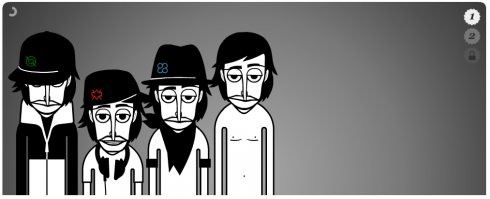I just like this picture.
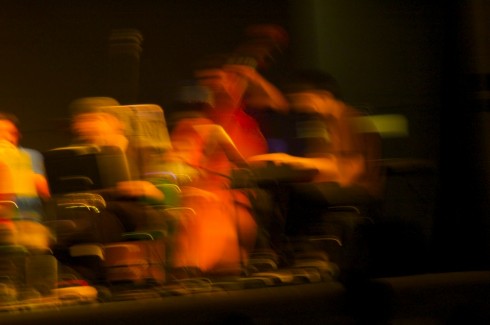
Middle and High School … from a Montessori Point of View

Last weekend, I took the Glass Art Sampler class at the Third Degree Glass Factory, and got to try my hand at making a paperweight, a glass tile, and a few beads. It was awesome.
I’d had the chance to make a paperweight when my Lamplighter class had visited St. Louis a couple years ago, so I had a general idea of some of the possibilities. This time, however, I had DNA sequences on the brain, and went in with a bit of a theme in mind.
The tiles were the easiest because all you need to learn how to do was cut glass — by scoring it and using a little pliers like device to break it along the score — and then arrange the tiles of colored and clear glass on a tile. The arrangement was placed in a flat kiln, and then a day or so later, you tile would be all melted together. Pretty simple for a beginner.
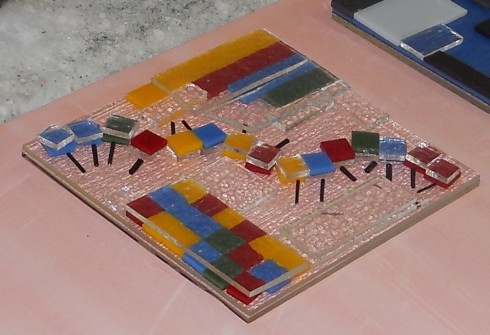
There is, of course, a bit more to it than that. The way the glass is stacked can be used to create floating effects; some colors will react when melted in the kiln to give different colors; care needs to be taken to manage where bubbles show up in the cooled glass; among other things.
Since it’s easiest to make straight edged cuts in glass, I made four sets of square colored tiles — yellow, red, blue, and green — to make a nucleotide sequence based off the DNA Writer translation table (with the start and stop codons added in).
I tried something similar when making the paperweight.
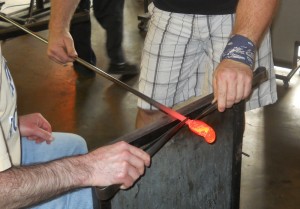
Usually, you start with a blob of molten, clear glass on the end of a metal rod, and dip it into trays of colored glass shards that stick to the molten glass. You can then pull and twist the viscous glass with a large pair of tweezers to blend the colors and make pretty patterns. The twisted glass is then pushed into a blob at the end of the rod, and the whole thing encased in more clear glass.
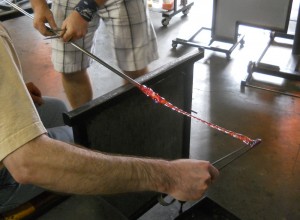
Instead, I wanted to create a discernible pattern of colors to create a multi-colored helix of molten phenocryst-like blobs in the clear glass. I really wasn’t sure how to make it work. I though perhaps I could dip the initial glass blob into a pattern of shards and then pull it out once while twisting to get the spiral pattern. Our instructor was patient as I tried to explain my ultimate goal, and he came up with a more subtle method for making the spiral.

I laid out the short pattern of colored glass shards and carefully dipped the initial blob of clear glass into it. All the shards stuck, which was good. Then instead of pulling with tweezers, the instructor helped my gently roll the blob of glass along a metal surface at a slight downward angle. Contact with the metal cooled the tip of the glass faster than rest of the blob causing the whole thing to twist just nicely. After smoothing things with a block we covered it with more clear glass (and smoothed again), and were done.
One week later:
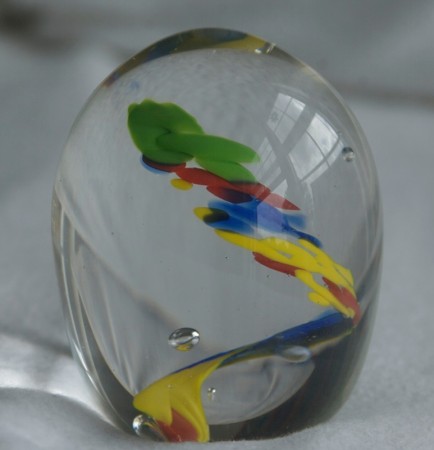
Working with big blobs of extremely hot glass is quite challenging, so I couldn’t replicate this on my own at the moment. I may have to take another class.
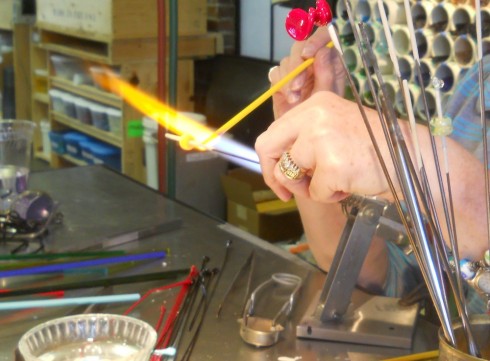
I would feel comfortable making glass beads after the one class, but mastering the art is going to take a lot of practice. The flame — created from a mix of fuel gas (propane I think) and oxygen — is quite hot, and it takes some expertise to be able to melt the glass and twirl it onto the rods to make a nice round bead. The trickiest part, however, is making little colored dots to decorate the bead. You need to melt small bits of glass for the dots, then move the bead through the flame to warm it up enough so the dot will stick to the bead while not melting the bead too much. Then you pass the bead through the flame again to set the dot. If the bead or the dot is too cool when they’re put together the dots will pop off. I had a lot of popping dots.
I was not able to get my nucleotide sequence onto a bead in the time I had, but I did at least get to make a couple beads.

Natsumi Hayashi has a wonderfully addictive blog of levitating people (and sometimes, non-levitating cats).

[Michael Bay] earns approximately 3.2 million $ for every explosion in his movies and a Michael Bay movie without explosions would earn 154.4 million $. This means that if Michael Bay wants to make a movie that earns more than Avatar’s 2781.5 million $ he has to have 817 explosions in his movie.
— Reddit:User:Mike-Dane: Math and Movies on Imgur.com.

Reddit user Mike-Dane put together these entertaining linear regressions of a couple directors’ movie statistics. They’re a great way of showing algebra, pre-algebra, and pre-calculus students how to interpret graphs, and a somewhat whimsical way of showing how math can be applied to the fields of art and business.
Linear regression matches the best fit straight-line equations to data. The general equation for a straight line is:
y = mx + b
where m is the slope of the line — how fast in increases or decreases == and b is the intercept on the y-axis — which gives the initial value of the function.
So, for example, the Micheal Bay, profits vs. explosions, linear equation is:
Profit (in $millions) = 3.2 × (# of explosions) + 154
which means that a Michael Bay movie with no explosions (where # of explosions= 0) would make $154 million. And every additional explosion in a movie adds $3.2 million to the profits.
Furthermore, the regression coefficient (R2) of 0.89 shows that this equation is a pretty good match to the data.
Mike-Dane gets an even better regression coefficient (R2 = 0.97) when he compares the quality of M. Night Shyamalan over time.
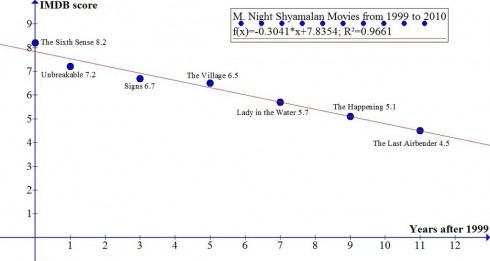
In this graph the linear regression equation is:
Movie Score = -0.3014 × (year after 1999) + 7.8354
This equations suggests that the quality of Shyamalan’s movies decreases (notice the negative sign in the equation) by 0.3014 points every year. If you wanted to, you could, using some basic algebra, determine when he’d score a 0.
Loveliest of trees, the cherry now
Is hung with bloom along the bough,
And stands about the woodland ride
Wearing white for Eastertide.Now, of my threescore years and ten,
Twenty will not come again,
And take from seventy springs a score,
It only leaves me fifty more.And since to look at things in bloom
Fifty springs are little room,
About the woodlands I will go
To see the cherry hung with snow.–Alfred Housman (1896): from A Shropshire Lad.
Use Tone Matrix to generate music by clicking squares on a grid.
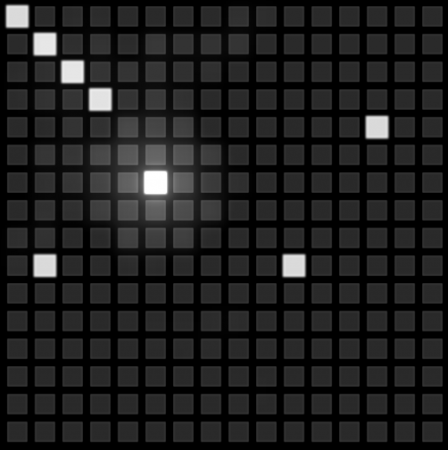
Another good music app comes from Incredibox:
